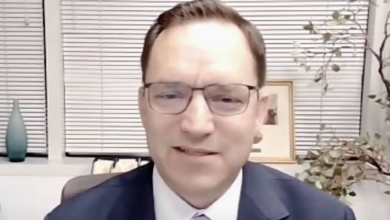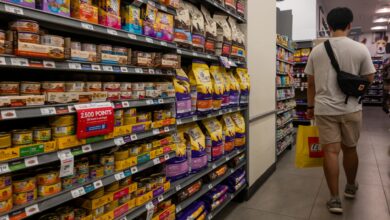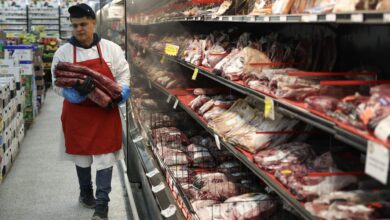Can Saudi Arabia keep pace with its ambitious mega-project spending spree?
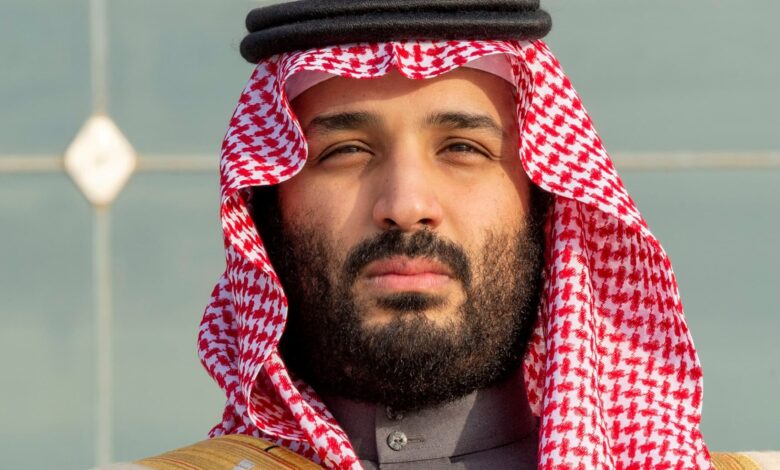
Digital render of NEOM’s The Line project in Saudi Arabia
The Line, NEOM
In Saudi Arabia’s northwestern desert, a sprawling construction site replete with cranes and pile drivers sits encircled by a recently-built road. A pair of tracks cuts through the site like deep gashes through the sand, comprising the spine of what planners say will be a high-speed rail system.
The skeletal infrastructure forms the foundations of The Line, a multi-billion dollar high-tech city that its architects say will eventually house 9 million people between two 106-mile long glass skyscrapers more than 1,600 feet high.
The project, whose estimated cost is in the hundreds of billions, is just one of the hyper-futuristic venues planned in Neom, the brainchild of Saudi Crown Prince Mohammed bin Salman and a region that the kingdom hopes will bring millions of new residents to Saudi Arabia and revolutionize living and technology in the country. It’s a core pillar of Vision 2030, which aims to diversify the Saudi economy away from oil revenues and create new jobs and industries for its burgeoning young population.
The cost of Neom has been estimated to be as high as $1.5 trillion. In the years since it was announced, Saudi Arabia’s Public Investment Fund, the mammoth sovereign wealth fund now overseeing $925 billion in assets, has poured billions into overseas investments, with ever-increasing waves of foreign investors flying to the kingdom to raise cash.
This year, however, has seen a sharp change in direction in terms of spending, with a stated emphasis on keeping investments at home along with reports of cutting costs on megaprojects like those in Neom. The changes come as the Saudi deficit grows and the outlook for oil demand, along with global oil prices, sees sustained lows.
Construction for The Line project in Saudi Arabia’s NEOM, October 2024
Giles Pendleton, The Line at NEOM
That begs the question: does Saudi Arabia have enough money to meet its lofty goals? Or will it have to be more flexible to make its spending trajectory sustainable?
One Gulf-based financier with years of experience in the kingdom told CNBC: “The PIF’s pivot towards domestic investments, widely acknowledged but now officially admitted, suggests that there is still a lot of spending needed. Saudi Arabia has poured tens of billions into projects that have yet to hint of any financial returns.”
The financier spoke anonymously as they were not authorized to speak to the press.
Andrew Leber, a researcher at Tulane University who focuses on the political economy of the Middle East, believes that the current pace of spending won’t last.
“The number of ‘we pay up front and hope for economic returns later’ giga projects that are currently underway is not sustainable,” Leber said.
“With that being said,” he added, “the Saudi monarchy has shown itself to be somewhat flexible whenever economic realities assert themselves. I do think that eventually, a number of projects will be quietly shelved in order to bring its fiscal outlays back into greater sustainability.”
Digital render of NEOM’s The Line project in Saudi Arabia
The Line, NEOM
Saudi Arabia in October cut its growth forecasts and raised its budget deficit estimates for the fiscal years 2024 to 2026 as it expects a period of higher spending and lower projected oil revenues. Real gross domestic product is now expected to grow 0.8% this year, a dramatic drop from a previous estimate of 4.4%, according to the ministry of finance.
The kingdom’s economy also swung dramatically from a budget surplus of $27.68 billion in 2022 to a deficit of $21.6 billion in 2023 as it ramped up public spending and decreased oil production due to its OPEC+ supply cut agreement. Its government forecasts a deficit of $21.1 billion for 2024, projecting revenue at $312.5 billion and expenditures at $333.5 billion.
Saudi authorities expect that the budget will remain in deficit for the next several years as it pursues its Vision 2030 plans, but they add that they are fully prepared for this.
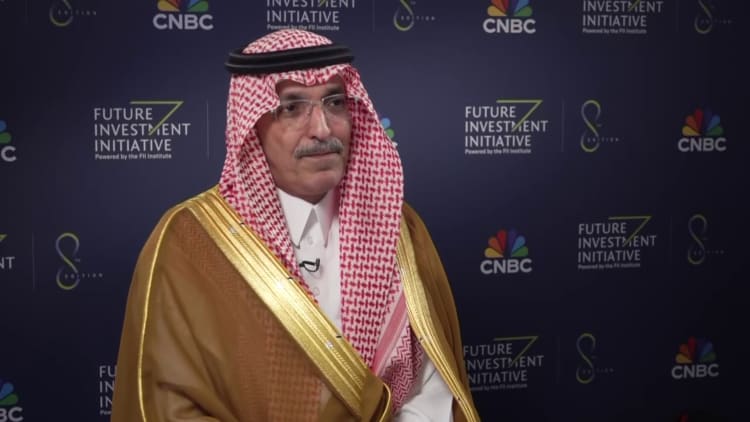
“Our non-oil revenues have grown significantly, now it covers about 37% of expenditure. That’s a significant diversification, and that gives you a lot of comfort that you can maneuver and be stable despite the fluctuation in oil price,” Saudi Finance Minister Mohammed Al-Jadaan told CNBC in October. “Our aim is to make sure that our plans are stable and predictable.”
“We are not going to blink, we have significant fiscal resource under our disposal, and we are very disciplined in our fiscal position,” the minister said.
Saudi Arabia has an A/A-1 credit rating with a positive outlook from S&P Global Ratings and an A+ rating with a stable outlook from Fitch. That combined with high foreign currency reserves — $456.97 billion as of September, a 4% percent increase year-on-year, according to the country’s central bank — puts the kingdom in a comfortable place to manage a deficit, economists told CNBC.
Riyadh is successfully issuing bonds, tapping debt markets for more than $35 billion so far this year. The kingdom has also rolled out a series of reforms to boost and de-risk foreign investment and diversify revenue streams, which S&P Global said in September “will continue to improve Saudi Arabia’s economic resilience and wealth.”
When asked if the kingdom’s spending trajectory is sustainable, Al-Jadaan replied: “Absolutely, yes,” adding that the government recently published its numbers for the next three years and that “we think it is very sustainable.”
Still, many analysts outside the kingdom, as well as individuals working within the kingdom and on NEOM projects, are skeptical of the megaprojects’ feasibility. Reports that some projects have been dramatically cut down — in the case of the Line, its size target slashed from 106 miles to 1.5 miles and population target down from 1.5 million by 2030 to less than 300,000 — attest to that concern on a higher level.
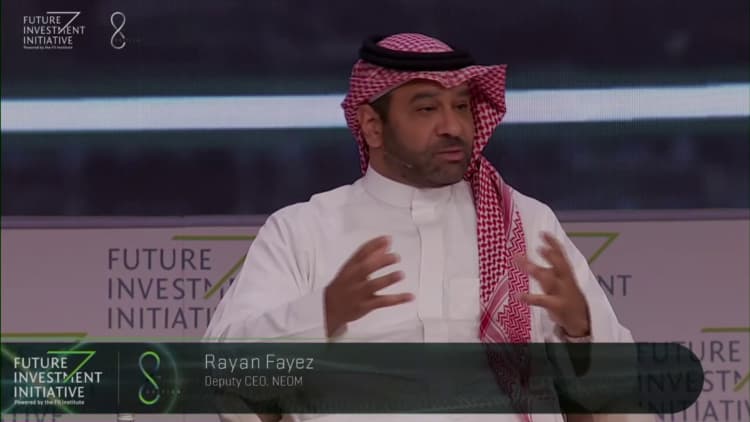
Neom executives acknowledge that the current phase of work on The Line is for a building length of 1.5 miles — which would still make it the longest building in the world. However, the eventual goal of 106 miles has not changed, they say, stressing that cities are not built overnight and that construction is continuing apace.
For Tarik Solomon, chairman emeritus at the American Chamber of Commerce in Saudi Arabia, “it’s promising to see transparency and some project cutbacks.”
“The Kingdom’s rising external borrowing reflects challenges with Vision 2030 feasibility,” he told CNBC.
“Though debt remains manageable at 26.5% of GDP, continued small pressures add up, underscoring the need for fiscal discipline and achievable goals.”
Solomon pointed to the desire of many Saudi residents for improvements to the infrastructure they use in their daily lives — like Riyadh’s public transport, network connectivity, schools, and health care.
“The road to resilience for Saudi Arabia isn’t in figuring out ski slopes in the desert but in building with innovation, complexity, and the courage to pursue what’s truly impactful,” he said.

